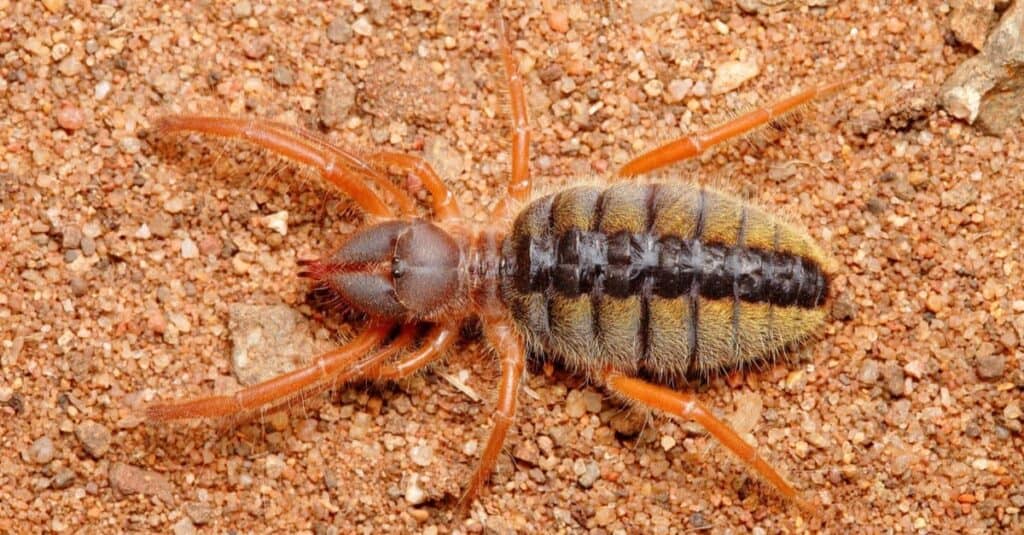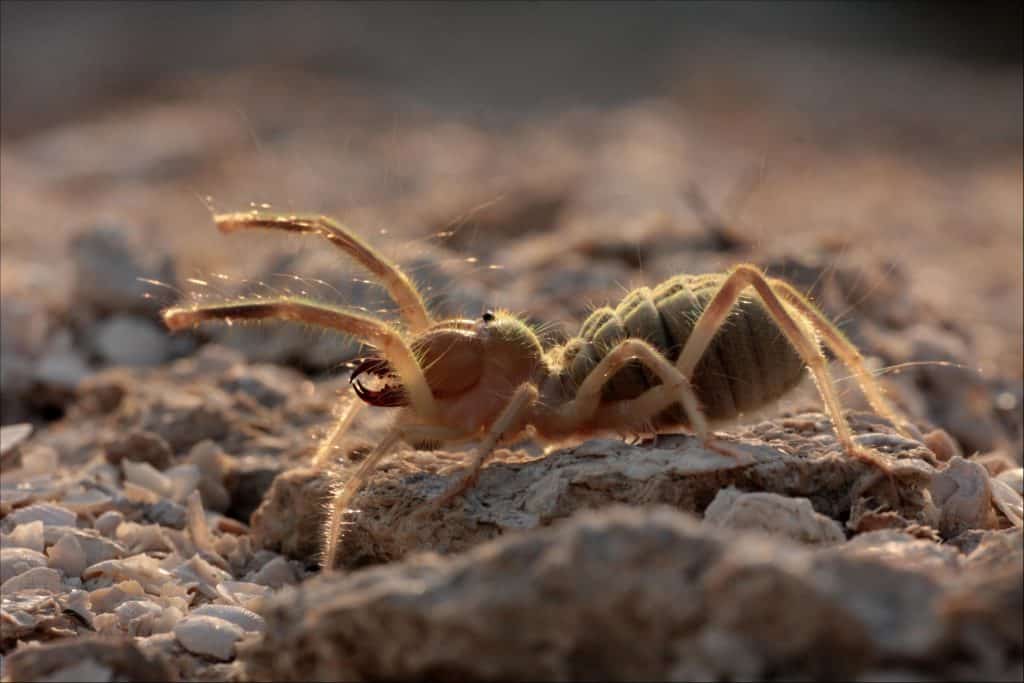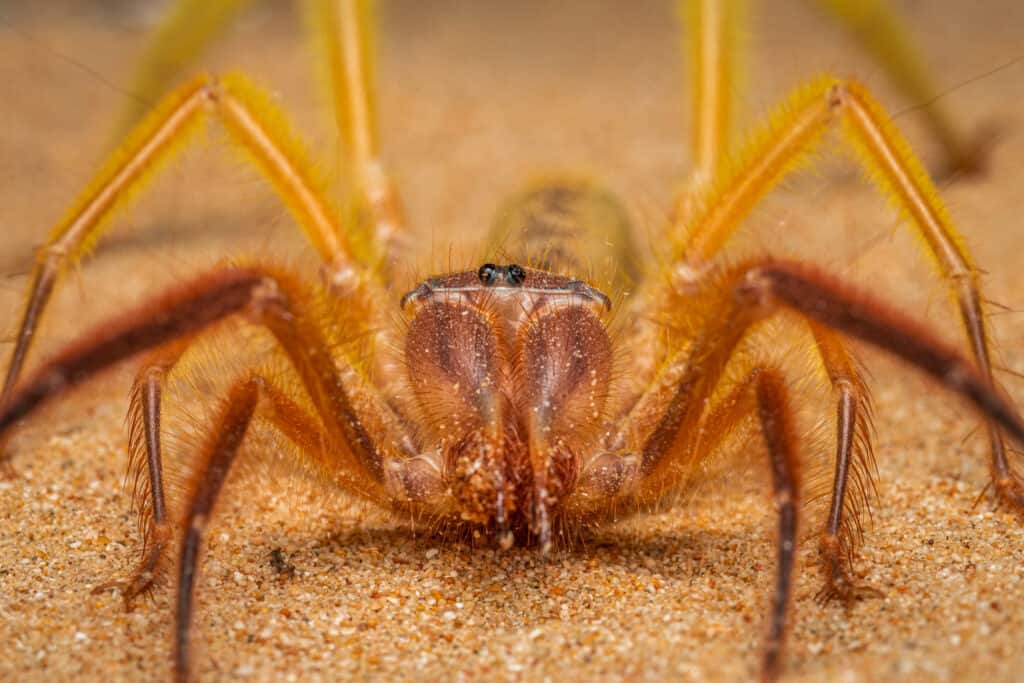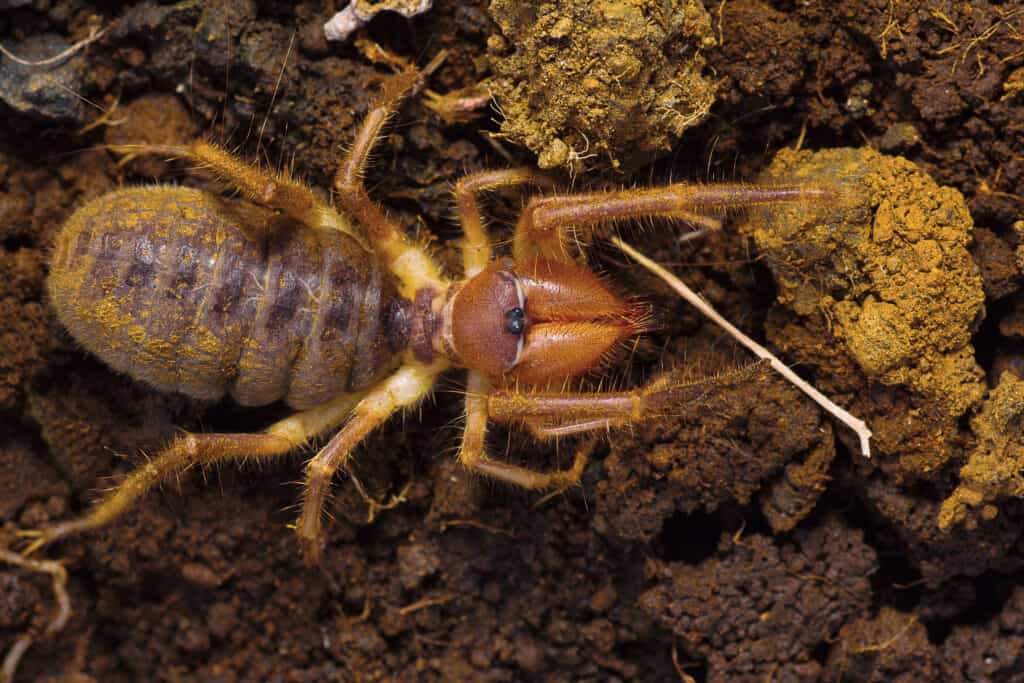Camel spiders live in the deserts and scrublands of the Middle East, southwestern United States, and Mexico.
Camel spider facts mean that they look like something out of a horror movie, among many others. A considerable body, long legs, giant jaws, and the ability to run 10 miles per hour are some quirky but impressive camel spider facts. There are also many myths surrounding this weird creature. Still, we debunk some myths surrounding this oddity while adding other interesting facts about the camel spider.
1. Camel Spider Myths and Facts – Where It Gets Its Name

Camel spiders inhabit regions in the Middle East, southwestern U.S., and Mexico.
©Ondrej Michalek/Shutterstock.com
People used to think camel spiders would eat the insides of a camel’s stomach. This myth has been debunked, but the name has stuck with these spiders. But besides being known as camel spiders, they are also known as wind scorpions, sun spiders, and the Egyptian Giant solpugid. Camel spiders are part of the Solpugidae family and the class Arachnida. Scientists have discovered over 1,000 species of camel spider.
2. It May Look Like a Camel Spider Has 10 Legs
Camel spiders have eight legs, but they have two long pedipalps near their mouths. The pedipalps are a pair of appendages that look like an extra pair of legs. Camel spiders use their pedipalps to find and grasp their prey. The camel spider’s legs, and the rest of its body, are covered with tiny brown hairs that are tan and dark brown. These fine hairs insulate the camel spider’s body from the heat of the desert. Their tan and dark brown colored hairs camouflage the spider in their environment while offering protection against the elements. Camel spiders grow to about three to six inches long and weigh roughly two ounces.
3. Camel Spider Sometimes Chase Humans

Camel spiders cannot create webs like most other spiders, so they shelter under rocks and branches.
©Dmitry Fch/Shutterstock.com
Some people believe that camel spiders will chase them to bite them. Still, if a camel spider chases a human, it is likely because the spider wants to sit in their shadow. Camel spiders live in hot desert areas with little shelter and few cool spaces. Suppose a camel spider comes in contact with a person’s shadow, and the person moves away. In that case, the spider might hurry toward the person for shade. Camel spiders are also fast and can run up to 10 miles per hour. These spiders may be aggressive, but people rarely come in contact with them as they are nocturnal.
4. Camel Spiders Live in Hot, Dry Deserts and Scrublands
You will find these spiders in the deserts and scrublands of the Middle East, southwestern United States, and Mexico. During the day’s heat, they rest in rock crevices and underneath logs. These spiders are nocturnal and hunt during the cool of the night. Camel spiders are non-migratory animals that stay in the desert or scrubland for their entire lives.
5. Camel Spiders Are Carnivores

Camel spiders are opportunistic predators and will eat whatever is available in their environment, even if the animal is bigger than them.
©iStock.com/Sheril Kannoth
Camel spiders love eating lizards, small birds, gerbils, beetles, snakes, and termites. These spiders are opportunistic predators and will eat whatever is available in their environment, even if the animal is bigger than themselves. Camel spiders use their pedipalps to sense their prey before grabbing them with their jaws. Then they consume their target for the nutrition and water they provide. Camel spiders absorb these elements by dissolving their catch with their digestive juices. Once their prey becomes a pulpy liquid, the spider will ingest the meal.
6. Camel Spiders Are Prey For Nocturnal Animals – A Sad Fact
Animals that eat camel spiders are toads, scorpions, and bats. These animals are also nocturnal and hunt camel spiders at night when the spiders are out looking for food. Some desert toads are bigger than camel spiders and can easily catch them. Scorpions are often not larger than camel spiders. Still, they may overpower and eat them. Bats will use echolocation to find the camel spider before flying down to retrieve and eat it. An additional threat to camel spiders is starvation. Camel spiders will store fat if food sources are low, but if there are no food sources and the camel spider has not been able to store fat, it can die of starvation.
7. Camel Spider Bite Are Nasty But Not Lethal

Female camel spiders lay between 50 and 250 eggs.
©iStock.com/Willem Van Zyl
If a person threatened a camel spider, it might retaliate by biting them. However, camel spiders are not venomous but have massive jaws that will pierce the skin. Should they bite you, it will be a painful experience. Often, the wound will become infected if the victim does not treat it fast enough.
8. Female Spiders May Die After Laying Eggs
When camel spiders breed, the male will chase a female before mating. After mating, the female spider will spend time hunting and storing fat before she lays her eggs. After 11 days, the female will lay the eggs in a burrow she has dug in the ground. Female camel spiders usually lay between 50 and 250 eggs. Females will stay in the shelter with the eggs until they hatch. If she has not stored enough fat, she may die of starvation in the burrow because females refuse to leave the den until the eggs have hatched. The eggs start hatching from three to four weeks, and the spiderlings begin hunting for insects. Camel spiders live for up to one year.
9. They Communicate Through Seismic Vibrations
Arachnids communicate through oscillations called seismic vibrations. The spider will use a different vibration level depending on the activity or message. For example, the vibration level will differ when they are courting, warning a rival, or catching prey.
10. Camel Spiders Don’t Scream

Camel spiders cannot scream but can make a hissing or buzzing sound because of stridulation.
©iStock.com/ePhotocorp
There is a common myth that camel spiders scream while chasing their prey or even humans. Camel spiders cannot scream but can make a hissing or buzzing sound because of stridulation. Stridulation is when a spider rubs two body parts together. This friction makes the hissing or buzzing sound, but they cannot create a screaming sound.
Up Next – Spider Facts and Fiction
- Redback Spider
- Wolf Spider
- False Widow Spider
- Is the Spider an Insect?
- The Deadliest Spider in the World
The photo featured at the top of this post is © iStock.com/ePhotocorp
Sources
- A-Z-Animals, Available here: https://a-z-animals.com/animals/camel-spider/
- Live Science, Available here: https://www.livescience.com/40025-camel-spiders-facts.html
- Ingwelala, Available here: https://ingwelala.co.za/archives/fauna-flora/solifugids.html
- Smithsonian Magazine, Available here: https://www.smithsonianmag.com/science-nature/camel-spiders-are-fast-furious-and-horrifically-fascinating-180964439/
- The Burke Museum, Available here: https://www.burkemuseum.org/collections-and-research/biology/arachnology-and-entomology/spider-myths/myth-too-many-camel-spider
Thank you for reading! Have some feedback for us? Contact the AZ Animals editorial team.






